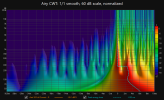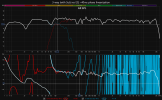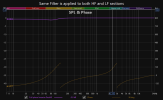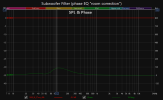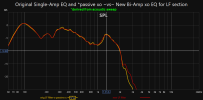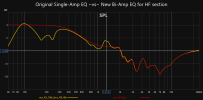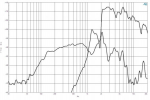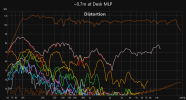Keith_W
Major Contributor
- Thread Starter
- #301
After a week of trying out different experiments with the driver phase linearization procedure, and generating a whole bunch of filters and listening:
- drivers individually amplitude and phase linearized with reverse AP filter
- drivers amplitude linearized only with no phase linearization with reverse AP filter
- SOME drivers amplitude linearized AND phase linearized, others left alone (given it is a 4-way system there are a lot of permutations! I settled on only phase linearizing the woofers and midrange horns)
- no driver linearization, only overall room correction with reverse AP filter
... I have concluded: there is a definite audible difference with phase linearization in any form, even if the frequency response looks the same. It is usually negative, it has the effect of dulling the sound, introducing a smearing quality, killing liveliness and dynamics. This is either due to the correction itself, or some artefact introduced by the correction which I have not recognized because I don't know where to look.
I have not found a "target curve" for phase, or even know what it should ideally look like. Perhaps one does not exist.
I am even more confused now, because phase is supposed to be inaudible. Yet I will swear under oath that I am not lying, the difference is easily audible. As mentioned, I don't know if this is the correction itself which is producing the audible difference, or an artefact introduced by the correction. I even tried doing a mono recording (both speakers playing together) to look for possible comb filtering which may account for the difference in tonality ... but nothing.
In the end, I made this decision: if you don't know what you are doing, it is better to do nothing. So I removed all phase corrections, and it sounds wonderful now. I mentioned upthread that without any phase linearization, it seems to "unleash" the speakers. They are so aggressive, and so dynamic. The "fatiguing" quality I noted earlier has gone after the filter "burned in" my ears. In fact, I find I prefer my correction over Dr. Uli's ... and the only difference between his correction and mine is that his has individual driver phase linearization.
- drivers individually amplitude and phase linearized with reverse AP filter
- drivers amplitude linearized only with no phase linearization with reverse AP filter
- SOME drivers amplitude linearized AND phase linearized, others left alone (given it is a 4-way system there are a lot of permutations! I settled on only phase linearizing the woofers and midrange horns)
- no driver linearization, only overall room correction with reverse AP filter
... I have concluded: there is a definite audible difference with phase linearization in any form, even if the frequency response looks the same. It is usually negative, it has the effect of dulling the sound, introducing a smearing quality, killing liveliness and dynamics. This is either due to the correction itself, or some artefact introduced by the correction which I have not recognized because I don't know where to look.
I have not found a "target curve" for phase, or even know what it should ideally look like. Perhaps one does not exist.
I am even more confused now, because phase is supposed to be inaudible. Yet I will swear under oath that I am not lying, the difference is easily audible. As mentioned, I don't know if this is the correction itself which is producing the audible difference, or an artefact introduced by the correction. I even tried doing a mono recording (both speakers playing together) to look for possible comb filtering which may account for the difference in tonality ... but nothing.
In the end, I made this decision: if you don't know what you are doing, it is better to do nothing. So I removed all phase corrections, and it sounds wonderful now. I mentioned upthread that without any phase linearization, it seems to "unleash" the speakers. They are so aggressive, and so dynamic. The "fatiguing" quality I noted earlier has gone after the filter "burned in" my ears. In fact, I find I prefer my correction over Dr. Uli's ... and the only difference between his correction and mine is that his has individual driver phase linearization.


